- Comics
- Comics Reviews
- Manga
- Comics Reviews
- European Comics
- News
- Comics News
- Press Releases
- Columns
- Spotlight
- Digital Comics
- Webcomics
- Cult Favorite
- Back Issues
- Webcomics
- Movies
- Toys
- Store
- More
- About
By Christopher Moshier
July 23, 2006 - 02:24
June 1938.
No literary character is going to be remembered more in the 20th century than the alien from Krypton who crash landed on Earth and became her protector. The character of Superman was a unique creation for the time and built a foundation for “Super Hero” related creations for years to come. When we look through the origins of American Literature Superman was truly a breakthrough character during a time when our own future was uncertain in the aftermath of a depression and the beginnings of what could be a major war.
Initially, Jerome Siegel and Joseph Shuster created Superman in 1934 as a newspaper comic strip submitted to syndication and rejected. A man named M.C. Gaines bought the feature for a new comic he was packaging, the now famous Action Comics #1. The newspaper adventure strip was cut up and reassembled into comic book pages. Action Comics was a success. Through the years Superman has generated a wealth of sales for the comic book industry which generated the character into other media, namely, radio, television, and movies. The following is a dedication to those men and woman that captured our imaginations as the Man of Steel and his extended family.
Clayton "Bud" Collyer (Clayton Johnson Heermance Jr)
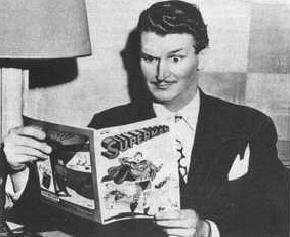 |
Born Clayton Johnson Heermance Jr. on July 19, 1883 in Vienna, Austria-Hungary (now Austria). Most of Clayton's family was in show biz, but he initially decided to go into his father's field, law. He worked his way through Fordham University as a radio actor and singer, then took a job as a law clerk. Two years later, realizing that radio was very much more lucrative a career, he changed his last name to Collyer and became a full-time actor. He was performing on every major network by the age of 32. Collyer assumed his most famous radio role in 1940 - the title character in "The Adventures of Superman."
"Faster than an airplane, more powerful than a locomotive, impervious to bullets!"
"Up in the sky - look!"
"It's a giant bird!"
"It's a plane!"
"It's SUPERMAN!"
"And now, Superman - a being no larger than an ordinary man but possessed of powers and abilities never before realized on Earth: able to leap into the air an eighth of a mile at a single bound, hurtle a 20-story building with ease, race a high-powered bullet to its target, lift tremendous weights and rend solid steel in his bare hands as though it were paper. Superman - a strange visitor from a distant planet: champion of the oppressed, physical marvel extraordinary who has sworn to devote his existence on Earth to helping those in need!" – Original Radio Opening
Did you know the characters of Daily Planet editor Perry White and photographer Jimmy Olsen were created for the original radio series? Did you know the Man of Steel encountered Kryptonite on the radio before it appeared in the Superman comic books? Did you know Superman teamed up with Batman and Robin on the airwaves before the trio joined forces in the pages of Superman and World's Finest? Well...now you do.
Superman flew from the pages of Action Comics and a comic of the same name onto the radio airwaves beginning Monday, February 12, 1940 starring Clayton "Bud" Collyer as the voice of the Man of Steel. Collyer used different voices for Superman and Clark Kent, while making good use of the well-known lines 'This is a job for Superman!' and 'Up, up, and away!'
“Bud” Collyer's decade-long tenure as radio's Superman was the longest run of any star of a radio adventure serial, lasting more than 2,000 shows. The 15-minute Mutual serial ran five days a week through January 28, 1949, then continued until June 17, 1949 as a thrice-weekly half-hour program, one year before the series ended. Collyer played Superman and Clark Kent in 325 syndicated episodes, through 1,610 15-minute shows, and 73 half-hour episodes on Mutual and ABC.
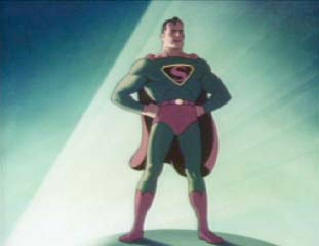 |
"Faster than a speeding bullet!
"More powerful than a locomotive!"
"Able to leap tall buildings at a single bound, this amazing stranger from the planet Krypton, the Man of Steel - SUPERMAN!"
"Possessing remarkable physical strength, Superman fights a never-ending battle for Truth and Justice, disguised as a mild mannered newspaper reporter, Clark Kent." – opening narrative from the Max Fleischer Cartoons
With Collyer a big success on the airwaves made it only obvious to Max Fleischer Studios to cast him as the Man of Steel for their theatrical shorts. The Fleischer studio was initially based in New York and was famous for its rambunctious, rough-and-ready presentation of characters like Betty Boop and Popeye. Joe Shuster drew the model sheets for Lois Lane, Clark Kent, and Superman. The first cartoon received critical acclaim and was nominated for an Academy Award. In 1942, Paramount Studios acquired Fleischer Studios and gave it the new name of "Famous Studios." They produced the last 8 of the 17 shorts and continued the series until 1943.
Collyer became involved in radio game shows at about the same time. He was co-host of ABC's "Break the Bank" for five years and host of "Winner Take All." Among the few radio personalities to successfully transition into television, he hosted the TV versions of his two radio shows. In early 1950, Collyer became host of "Beat the Clock," which ran in primetime and daytime for the next 11 years. In late 1956, he also became the host of his biggest success, "To Tell the Truth.” This lasted for 12 years and made his "Will the real [contestant's name] please stand up?" a part of the American lexicon.
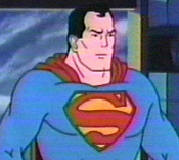 |
He would return for the dual role of Superman and Clark Kent in “The New Adventures of Superman” in the 1966 Televised Filmation Animated Show. The new adventures were approx. 8 min long in a half-hour program showing two Superman episodes and one Superboy episode. The Superboy cartoons are of Superman when he was a boy in Smallville, Kansas.
On September 11, 1972, one year after his last appearance on "To Tell the Truth," Collyer died of a circulatory ailment at age 61.
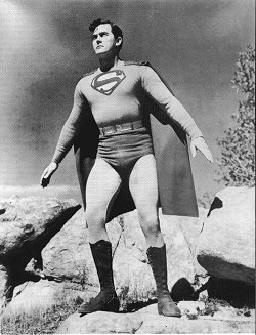 |
Kirk was born John Feggo Jr. on October 8, 1910 in Oxford, New Jersey. Starting his show business career as a chorus boy on Broadway and an entertainer in vaudeville, Kirk Alyn played bit parts and minor supporting roles in several low-budget films before getting his big break playing the title role in the 1948 serial "Superman."
Sam Katzman, who had made dozens of highly successful movies for Columbia, was chosen as the producer for the 1948 15-chapter Superman serial to be directed by Spencer Bennet. The special effects scenes of Superman in flight were animated in a style similar to the Fleischer cartoons. The series was credited as being "Adapted from the Superman Radio Program broadcast on the Mutual Network." It did contain such radio-show inventions as the Daily Planet, Kryptonite, and the characters of Perry White and Jimmy Olsen, but Superman's origin in the movie serial was from the 1942 George Lowther Superman novel titled “The Adventures of Superman” originally published by Random House. In the first chapter of the serial, Superman, played by Alyn, comes to Earth. It is revealed that Krypton, Superman's home planet, boasted a race of super men and women. Among the leaders of the planet was Jor-el, foremost man of science, who had planned to build a mammoth fleet to rescue the population of Krypton from destruction by transporting everyone to Earth. Krypton was governed by a council, which was led by Ro-zan. Additionally, Clark Kent's foster father is named "Eben,” but his foster mother's name is never given. She makes him his Superman costume from the fireproof blankets that he was wrapped in while an infant traveling to Earth from Krypton. His foster father gives him the name "Superman" and tells him that he must use his powers to fight in the cause of truth, tolerance, and justice. Both of his foster-parents pass away before he adopts the Superman mantle.
Superman became the most popular movie serial of all time and was followed up in 1950 with another 15-chapter serial, Atom Man vs. Superman. This featured the first on-screen appearance of that brilliant scientific madman, Lex Luthor. Luthor was played by an impressively stern Lyle Talbot, who says of the series "our approach was never to kid it...this had to be for real."
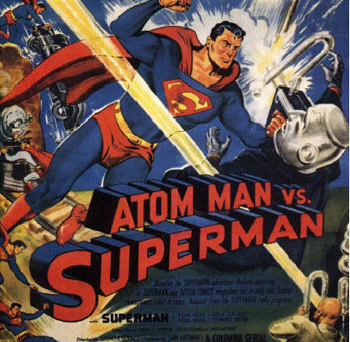 |
Atom Man vs. Superman had improved special effects, with animated bullets bouncing from Superman's chest and live-action scenes of Kirk Alyn in flight. It included many firsts, with Lex Luthor discovering the Phantom Zone and Lois Lane working as a television reporter for Luthor's TV station. Columbia's 43rd serial finds Lex Luthor, secretly the Atom Man, blackmailing the city of Metropolis by threatening to destroy the entire community. Perry White ( Pierre Watkin), editor of "The Daily Planet", assigns Lois Lane ( Noel Neill), Jimmy Olson ( Noel Neill), and Clark Kent/Superman to cover the story. Luthor invents a number of deadly devices to plague the city, including a disintegrating machine which can reduce people to their basic atoms and reassemble them in another place. But Superman manages to thwart each scheme. Since Kryptonite can rob Superman of his powers, Luthor decides to create a synthetic Kryptonite and putters about obtaining the necessary ingredients placing it at the launching of a ship, with Superman in attendance. He is exposed to the Kryptonite and passes out. Superman is taken away in an ambulance driven by Luthor's henchmen, and he is now under the control of Luthor. How will Superman ever get out of this one? That is the beauty of a serial...all you need to do is show up in one week to find out.
After the serial, Kirk Alyn was unable to sustain a film career and only after small parts in a few movies, retired to Arizona. He also had a cameo appearance in the 1978 Christopher Reeve movie, Superman: The Movie playing Lois Lane's father on the train that young Clark Kent raced on his way home from school. Kirk died March 14, 1999 of natural causes.
Michael Fitzmaurice (Michael Fitzmaurice-Kelly)
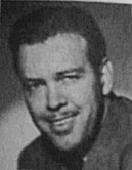 |
Michael Fitzmaurice was born Michael Fitzmaurice-Kelly April 28, 1908 in Chicago, Illinois. He took over as ABC's radio Superman where Clayton "Bud" Collyer left off from June 5, 1950 playing the role for 78 broadcasts of a revived final season. Superman left the radio airwaves on March 1, 1951. Fitzmaurice died August 31, 1967 of lymphoma.
George Reeves (George Keefer Brewer)
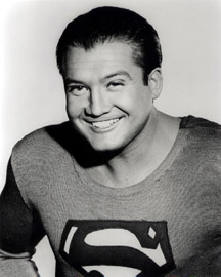 |
George Reeves was born as George Keefer Brewer January 5, 1914 in Woolstock, Iowa and raised in Pasadena California, educated at Pasadena Junior College, where he turned his attention toward music and acting, joining the acappella choir, playing guitar, and performing in school plays. In 1935, at the age of 21, he joined one of America’s most prestigious theaters, the Pasadena Community Playhouse. Over the next four years, he appeared in dozens of playhouse productions. The playhouse is where George met Ellanora Needles. They dated for two years and married on September 22nd, 1940. After nine years, they divorced with no children.
In 1943 George put his career on hold to enlist in the army, joining the Special Theatrical Unit of the U.S. Army Air Corps. He appeared in several training films, including a movie on the dangers of venereal disease. While stationed in New York, a theater director cast George in a small role in the play Winged Victory. After the show’s run on Broadway, he toured the country with the production company. Later, he re-created his role of Lieutenant Thompson in the film version of this play.
George received his big break when a scouting agent for Hollywood, producer David O. Selznick, cast him as Stuart Tarleton in the legendary 1939 film Gone With the Wind, starring Vivien Leigh and Clark Gable. His part in the film led to a contract with Warner Bros. Studios, who convinced George to adopt the stage name Reeves.
Although Reeves earned acclaim for his performance in Gone With the Wind, he went on to appear in a succession of less than memorable projects, including both 1940’s Tear Gas Squad, Calling All Husbands, and the 1941 Man at Large. However, in 1943, Reeves landed his first starring role in the box office hit So Proudly We Hail! in which he played a wounded World War II soldier who falls in love with costar Claudette Colbert.
In 1946, at the end of the war, Reeves returned to California. Over the next few years, his only film roles were in low-budget embarrassments like the 1948 films Jungle Goddess and Thunder in the Pines. Frustrated with dwindling opportunities in film, Reeves directed his efforts toward television work. In 1951, he reluctantly accepted the title role in the TV series The Adventures of Superman. Producer Barney Sarecky, arranged that the pilot film would be long enough to earn back its cost by playing in movie theaters as a feature film. Thus was born "Superman and the Mole Men,” the first full-length feature film.
"Faster than a speeding bullet! More powerful that a locomotive! Able to leap tall buildings at a single bound!"
"Look! Up in the sky!"
"It's a bird!"
"It's a plane!"
"It's - SUPERMAN!"
"Yes, it's Superman - strange visitor from another planet who came to Earth with powers and abilities far beyond those of mortal men. Superman! Who can change the course of mighty rivers, bend steel in his bare hands, and who, disguised as Clark Kent, mild-mannered reporter for a great metropolitan newspaper, fights a never-ending battle for Truth, Justice, and the American Way!" – 1960’s Opening Television Narrative
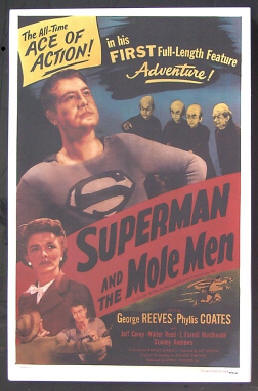 |
Reporters Clark Kent and Lois Lane arrive in the small town of Silsby to witness the drilling of the world's deepest oil well. The drill, however, has penetrated the underground home of a race of small, furry people who then come to the surface at night to look around. The fact that they glow in the dark scares the town folk, who form a mob, led by the vicious Luke Benson, intent on killing the strange people. Only Superman has a chance to prevent this tragedy.
These episodes were introduced to the airwaves in early 1953. Only sixty minutes in length, the pilot film was later shown as the only two-parter of the 30-minute series, under the title "The Unknown People". The first episode, Superman on Earth, featured Superman's origin much as it had been presented in the George Lowther novel: Krypton's ruling council was lead by "Ro-zan" - unlike the Ro-zan of the movie serials, who was a young contemporary of Jor-el, this Ro-zan was an elderly, white bearded statesman. The council was located in the "Temple of Wisdom" and Clark Kent's foster parents were named "Eben" and "Sarah" Kent, names taken directly from the novel. Many of its effects were lackluster. For a brief flying scene, the animation from the Columbia serials were borrowed.
In the fall of 1952, Superman premiered to high ratings and equally impressive critical acclaim. Playing both the crime-fighting hero (and his mild-mannered alter ego Clark Kent), Reeves quickly became a household name with younger viewers. However, as the popularity of the series swelled to a phenomenal level, Reeves became more and more dissatisfied with the direction in which his career was headed.
In 1953, Reeves was given a chance to rejuvenate his flagging film career with a substantial role in From Here to Eternity. However his hopes were crushed when a preview audience laughed and yelled “There's Superman” when Reeves first came on-screen. In the film’s final release, the actor appeared only momentarily and without screen credit. Typecasting brought Reeves’ career to a grinding halt and From Here to Eternity marked his last major motion picture.
After five successful seasons, Superman was canceled in 1957. In addition to his professional problems, Reeves was burdened by his relationship with Toni Mannix, the common-law wife of Eddie Mannix, vice president of Metro-Goldwyn-Mayer. In 1958, Reeves began a relationship with a young New York socialite, Leonore Lemmon. When he broke off his romance with Mannix, she was enraged, and began to harass the new couple, causing Reeves to file a restraining order against her.
On June 15, 1959, Reeves was found dead in his bedroom from a gunshot wound to the head. He was 45 years old. The police ruled his death a suicide, but rumors quickly surfaced that Reeves was murdered. Although Lemmon and Mannix were both suspected of killing Reeves, no arrests or convictions were made. His death remains shrouded in mystery.
A movie is coming out this year called "Hollywood Land" starring Ben Affleck as a private detective who, investigating the mysterious death of "Superman" star George Reeves, uncovers unexpected connections to his own life as the case turns ever more personal. The torrid affair Reeves had with the wife of a studio executive might hold the key to the truth.
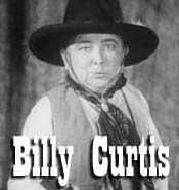 |
Midget actor Billy Curtis, born June 27, 1909, avoided the usual freak-show employment as a youth for someone his size, opting for a mainstream job as a shoe clerk. Encouraged by stock company actress Shirley Booth to take a little person role in a stage production, Curtis soon became a professional actor, with numerous Broadway musical productions to his credit. Curtis' big movie season was 1938-39: he was cast as the Mayor of the Munchkin City in 1939’s "Wizard of Oz" and as the cowboy hero of the all-midget western in 1938’s "Terror of Tiny Town". This last epic was one of the few instances that Curtis was cast as a good guy; many of his screen characters were ill-tempered and pugnacious, willing to bite a kneecap if unable to punch out an opponent. Seldom accepting a role that demeaned little people, Curtis played an obnoxious vaudeville performer compelled to sit on Gary Cooper's lap in the 1941 "Meet John Doe", a suspicious circus star willing to turn Robert Cummings over to the cops in 1942 Saboteur, and in 1957 as one of the many fair-weather friends of The "Incredible Shrinking Man".
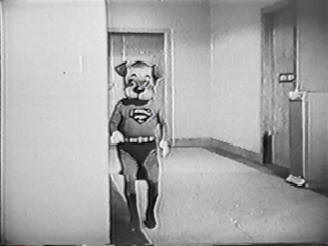 |
In 1958 Billy was to the lead in a pilot named "The Adventures of Superpup" meant to be a children's show with little people in dog costumes. Billy Curtis, star of "Superman and the Molemen," played Bark Bent who was a reporter working for Perry Bite. When the evil Professor Sheep dip kidnaps Pamela Poodle, it's our hero to the rescue. Faster than the speediest jet. More powerful than the mightiest rocket. Able to fly around the world faster than you can say "Superpup". Yes, it's Superpup, and only you and I know that Superpup is really Bark Bent, star reporter for the Daily Bugle. Needless to say, this pilot never became a series.
Billy Curtis' career thrived into the 1970s, notably with solid parts in the 1972 Clint Eastwood western "High Plains Drifter" and the 1973 crime-caper meller "Little Cigars", in which he had second billing as a diminutive criminal mastermind. Billy Curtis retired in the 1980s, except for the occasional interview or Wizard of Oz cast reunion. He died November 9, 1988 of a heart attack.
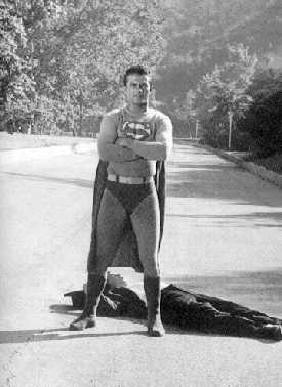 |
"I first studied acting with Agnes Moorehead at 20th Century Fox and then did a Playhouse 90 show as an extra. Paul Newman was the star and he suggested to me that I go back to New York and study with Sandy Meisner. It just so happened that Sandy once came out to see him, and I said, “I want to be in this class.” They said, “We're only taking professionals,” but I talked my way into the class. And who was in the class...Barbara Rush, John Erickson, Dyan Cannon and Terry Moore... few people. Before the Superboy pilot, I did a few things at ZIV, including Lockup, with MacDonald Carey. I also studied at Warner Brothers. They had an acting school. Ty Hardin and I did a film together called As Young As You Are for Paramount.
"When Superboy was casting, I was on the lot working on a pilot called Time Out for Ginger. As soon as I heard about the part being available, I went over and found out where the office was on a break. I walked in and Whitney Ellsworth was playing gin rummy with the head of the studio. I told him, “You don't have to look any further. I can fly.” I was also a very good gin player at the time, so I said I would play the winner. Whit won, so I started playing him and began winning. At that point I more or less knew I had the job. I did have to read a few lines, but I think I got the job because I was a good gin player.” – Johnny Rockwell, Superboy
In the pilot Johnny Rockwell starred as Superboy in the Adventures of Superboy. The plot revolves around Jimmy, Clark Kent and Lana Lang's friend, being ashamed that his father works as a doorman at the Smallville Theater. His opinion changes when Superboy is able to thwart a robbery with Jimmy's father's help.
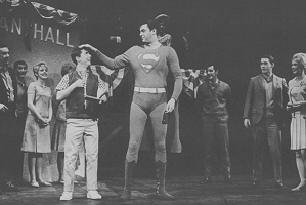 |
In 1966, a Broadway musical entitled "It's a Bird, It's a Plane, It's Superman" began its run. Songs by Charles Strouse and Lee Adams include “Superman,” “You've Got Possibilities,” and “Revenge.” The musical ran for 128 performances.
Superman must save himself and Metropolis from the Mad Scientist while coping with a super bout of depression. Aiding the villain is Daily Planet columnist Max Mencken, much to the horror of fellow writers Lois Lane and Sydney Carlton.
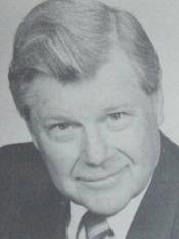 |
Bob Hastings was born April 18, 1925 in Brooklyn, New York. Making countless appearances in television of the 60’s and 70’s, he is probably most known for his role as Police Captain Burt Ramsey on the soap opera General Hospital from 1979 until 1986. Again, he played the long arm of the law as the voice of Commissioner James Gordon on all current incarnations of Batman: The Animated Series. In 1966, Hastings was the voice actor behind Superboy in the Adventures of Superman filmation cartoon.
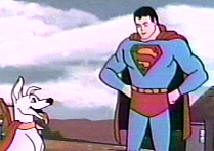 |
 |
Danny Dark began his career as a part of the Top 40 market in St. Louis during the early 1960's. When Danny left radio in 1965, he hit the voice-over jackpot. As one of the premiere commercial voices in the industry, Danny's golden tones could be heard for years on such spots as Mazda, Chevrolet and Budweiser “...this Bud's for you.” Danny was also the image voice for NBC TV for more than 25 years as well as TV shows like Bewitched and Bonanza, RCA TV commercials and Keebler cookies. From 1973 until 1986, Dan Dark portrayed the voice of Superman in the all the Hanna-Barbara incarnations; The All-New Superfriends Hour, Challenge of the Superfriends, Superfriends (1980-3), Superfriends- The Legendary Super Powers Show, The Super Powers Team: Galactic Guardians, and The World's Greatest Superfriends.
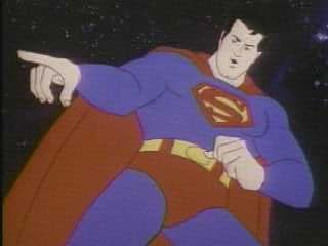 |
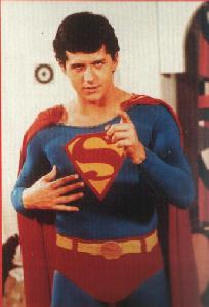 |
On February 21, 1975, ABC aired a 2 hour musical called 'It's a Bird, It's a Plane, It's Superman' based on the 1966 Broadway musical of the same name. In this TV adaptation, some of the lines were changed, but the musical's songs, plot and campy routines remained intact.
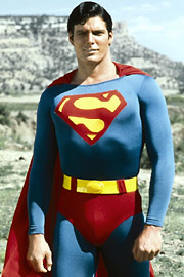 |
Christopher Reeve was born September 25, 1952, in New York City. When he was four, his parents (journalist 'Barbara Johnson' and writer/professor Franklin Reeve) divorced. His mother moved with sons Christopher and Benjamin to Princeton, New Jersey, and married an investment banker a few years later. After graduating from high school, Reeve studied at Cornell University, while at the same time working as a professional actor. In his final year of Cornell, he was one of two students selected (Robin Williams was the other) to study at New York's famous Juilliard School of Performing Arts, under the renowned John Houseman.
In New York City in 1976, Reeve was appearing in the off-Broadway production My Life. During that production, Reeve auditioned and successfully screen tested for the 1978 movie Superman. Reeve portrayed Superman as "somebody that, you know, you can invite home for dinner...someone you could introduce your parents to." He made Superman believable by playing him as a hero with brains and a heart. Reeve said, "What makes Superman a hero is not that he has power, but that he has the wisdom and the maturity to use the power wisely. From an acting point of view, that's how I approached the part." The 18 months of shooting for that movie took place mostly in England, where Reeve met and began a relationship with modeling executive Gae Exton.
With the major box office success of Superman the Motion Picture, Reeve went on the make 3 follow up sequels...
SUPERMAN I: Unable to convince the ruling council of Krypton that their world will destroy itself soon, scientist Jor-El takes drastic measures to preserve the Kryptonian race: He sends his infant son Kal-El to Earth. There, gaining great powers under Earth's yellow sun, he will become a champion of truth and justice. Raised by the Kents, an elderly farm couple, Clark Kent learns that his abilities must be used for good. The adult Clark travels to Metropolis, where he becomes a mild-mannered reporter for the Daily Planet...and a caped wonder whose amazing feats stun the city: Superman! Meanwhile, Lex Luthor, the world's greatest criminal mind, is plotting the greatest real estate swindle of all time. Can even the Man of Steel stop this nefarious scheme?
SUPERMAN II: Picking up where "Superman: The Movie" left off, three criminals from the planet Krypton are released from the Phantom Zone by a nuclear explosion in space. They descend upon Earth where they could finally rule. Superman, meanwhile, is in love with Lois Lane, who finds out who he really is. Lex Luthor escapes from prison and is determined to destroy Superman by joining forces with the three criminals.
SUPERMAN III: Wealthy businessman Ross Webster discovers the hidden talents of Gus Gorman, a mischievous computer genius. Ross decides to abuse his talents, in a way to help Webster with his plans for economic control. When the man of steel interferes, something must be done about Supes. When Gus' synthetic Kryptonite fails to kill Superman, it turns him in an evil incarnation of his former self. The tar-laced Kryptonite pits man against himself, setting up the Clark vs. Superman battle.
SUPERMAN IV (The Quest For Peace): Lex Luther steals a hair of Superman's head from a museum and uses it to create Nuclear Man, an android that gets energy from the Sun. His purpose of course is to use him as a weapon to kill Superman, so that Luther will be free to realize his criminal plans.
Reeve went on to appear in a total of 17 feature films, a dozen TV-movies, and about 150 plays. In addition, he has hosted or narrated numerous documentaries and TV specials, many of which involve interests of his such as aviation or stunt work.
In May of 1995, it was during the cross-country portion of an equestrian event in Culpeper, Virginia, that Reeve's Thoroughbred, Eastern Express, balked at a rail jump, pitching his rider forward. Reeve's hands were tangled in the horse's bridle and he landed head first, fracturing the uppermost vertebrae in his spine. Reeve was instantly paralyzed from the neck down and unable to breathe. Prompt medical attention saved his life and delicate surgery stabilized the shattered C1-C2 vertebrae and literally reattached Reeve's head to his spine.
Reeve continued to schedule many speaking engagements and ambitiously raise money for spinal cord injury research while looking to the future with characteristic enthusiasm saying: "My spinal cord is ready below the injury. I'm realistically optimistic. I don't plan to spend the rest of my life like this." Four hours of physical therapy a day has made possible Reeve recovering the movement of an index finger, wrist and thumb. Lobbying for highly controversial research using human embryos for embryonic stem cell research and cloning has become central to Reeve over more conventional research advancing like axon regeneration and nerve growth. Reeve said, "...I have a creative life and a political life, and they're both equally important." Reeve's oldest son, Matthew Exton Reeve, entered Brown University in 1999 majoring in art semiotics and in May 2002 graduated with a Bachelor of Arts degree. Matthew is also documenting his father's progress in recovery for three television specials he directed premiering in 2002 and 2003 with the first special airing around Reeve's 50th birthday. Reeve's daughter Alexandra, in 2001, entered Yale University in Connecticut and joined the Yale Polo Squad. Creatively, Reeve had in the works movie projects to direct for ABC television on the inspirational lives of Jeffrey Galli, Brooke Ellison, and Robert McCrum. He also was the Creative Consultant for Freedom: A History of US, a 16-part miniseries on public television about American freedom that aired in early 2003. On May 3, 2002 the U.S. government opened the National Health Promotion and Information Center for People With Paralysis, known as the Christopher and Dana Reeve Paralysis Resource Center through a non-competitive cooperative agreement awarded to the Christopher Reeve Paralysis Foundation. CRPF was designated in 2000 to establish the center through a line item in the Centers for Disease Control and Prevention budget and officially named the recipient of the cooperative agreement in May 2001. The official purpose of the center is to develop and expand national efforts for the prevention of secondary conditions and complications, and to improve outcomes and the quality of life for people living with paralysis from multiple causes.
Sadly Christopher Reeve died while in coma after going into Cardiac Arrest on Sunday, October 10th, 2005.
Reeve was being treated at Northern Westchester Hospital for a pressure wound that he developed, a common complication for people with paralysis. In the week leading up to his death, the wound had become severely infected, resulting in a serious systemic infection.
"On behalf of my entire family, I want to thank Northern Westchester Hospital for the excellent care they provided to my husband," Dana Reeve, his widow, said in a statement. "I also want to thank his personal staff of nurses and aides, as well as the millions of fans from around the world who have supported and loved my husband over the years."
Dana Reeve died this past March 2006 from cancer. She and Chris are now flying above us in the clouds!
I would like to thank the following sites for providing a wealth of information on Superman and the actors that portrayed the character and his super “friends”:
This is Part 1 of a two part series spotlighting the actors behind the "S". Check out the Comic Book Bin tomorrow for Part II!